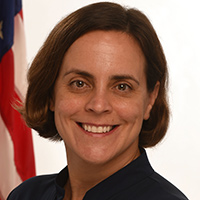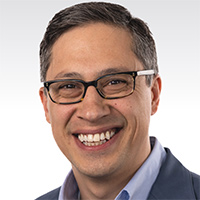What if …
… “we could make our joints heal themselves?”
… “we could eliminate viruses as current and future health threats?”
… “surgeries fix problems flawlessly the first time?”
These are among the questions the Advanced Research Projects Agency for Health (ARPA-H) hopes to answer. Initiated by the Biden Administration and funded by the U.S. Congress in 2022, the agency funds out-of-the-ordinary approaches to pursue biomedical breakthroughs that might not happen through the standard processes of federally-supported research.
“We try to have a vision for where we want to go with each initiative,” ARPA-H Director Renee Wegrzyn, PhD, said about the “what if” scenarios.
The agency applies market analysis to find projects that are most likely to produce health improvements, and helps to foster collaborations among academia, government, foundations, and corporations to initiate research and transition the projects to those collaborators for further investigation and development. With $2.5 billion in funding through fiscal year 2025, ARPA-H has launched six research programs — which include fostering tissue regeneration in joints, creating technology that gives surgeons precise views of tissue on which they are operating, and developing vaccines against entire families of viruses — and an across-the-board initiative to make clinical trials progress more quickly and enroll more diverse participants.
Wegrzyn and Chief Operating Officer Joe Shonkwiler, MD, recently sat for an interview with AAMCNews to talk about the priorities of ARPA-H, how its selection and research process differs from the way the federal government routinely funds research, and how it will measure success. The interview has been edited for clarity and brevity.
Why does ARPA-H exist? What problem is it trying to solve?

Renee Wegrzyn: There needs to be a place in the health ecosystem that allows us to take these really big bets in health research. ARPA-H is intended to be an agency for the next moonshots, and not predetermined to be aligned with a specific disease or technology. We ask, “Where could the U.S. government investment asymmetrically advance the state of the art and improve health outcomes?”
What industry does really well is think about and design for the customer, to make sure that somebody actually wants to adopt these new technologies, products, and processes. We’re making sure we have very clear ways to engage our customers, whether those customers are patients or health care providers. We need to iteratively collect their feedback throughout the course of a program, from the initial design to understanding the marketplace. Is there someplace for this product?
That innovation gap — from the lab to a startup company to [getting a product to] the real world — that’s so hard to do. We want to make sure we are contributing to building that transition community for the health ecosystem.

Joe Shonkwiler: When I joined [the agency], what really struck me was how Renee and the rest of the folks that were formulating that strategy, how familiar it was from what I had seen in my formative years in academic medicine. It’s problem focused. It is based on a hole out there in the ecosystem for these innovations in a way that I hadn’t seen in my mix of public-private sector experiences. I think it’s driven a lot of the interest within the academic medical community because they see how these problems could be solved with this new model.
How will ARPA-H projects differ from the way research projects are typically done?
Wegrzyn: We are not a top-down organization. I don’t set the agenda; Joe doesn’t set the agenda. Instead, we look to hire program managers who launch and oversee specific projects. They could be doctors; they could be technologists. They come to us with a specific problem in health care that they want to solve. If we’re excited about how they framed this well-defined problem, and they have insights into how it could be solved, we hire those folks and we give them a team.
[Note: these are full-time positions for which program managers leave their previous jobs. ARPA-H provides details about the positions.]
We have four program managers who are MDs. They’re practicing doctors, and they’ve encountered something [a health care challenge] where they’re not satisfied with the status quo. They see this opportunity to break through whatever barrier they’re facing to try to change the paradigm. Our jobs are to make sure we’re breaking down those walls and letting them focus on those programs.
Can you describe a couple of projects to illustrate how research is being selected and carried out differently, and what kind of difference that’s going to make?
Shonkwiler: Precision Surgical Intervention (PSI). The what-if question is, “What if surgeries fix problems flawlessly the first time?” It addresses two major surgical problems: tumor edge visualization and critical anatomy visualization. I was a surgical resident, and this one is near and dear to my heart.
The idea that you would use cutting-edge technologies to help distinguish between healthy and unhealthy tissue, or cancer and noncancerous tissue — that’s using technology to give surgeons a superpower. It has the potential to shift the whole landscape for what you can do intraoperatively, doing surgery the first time — and, hopefully, the last time — for cancers and other issues.
That program [PSI] is a case study in the ARPA-H approach. It incorporates a well-defined problem with clinical relevance for patients and for physicians of various specialties. It’s disease-agnostic. And it will incorporate the best in class for research and industry to make it a reality.
Can you tell us about another initiative, Advancing Clinical Trial Readiness [ACTR], and how that illustrates what ARPA-H brings to the process? As I understand it, ACTR will use a nationwide network of organizations in health care — through the ARPANET-H Health Innovation Network — to expand clinical trials to reach people in communities where they live and diversify clinical trial participation.
Wegrzyn: We have a “what if?” statement for ACTR: “What if 90% of all Americans were within 30 minutes of a clinical trial?”
There is going to be a clinical trial network. By working with a diverse array of institutions, we can get closer to the customers, whether they’re in rural settings or urban settings.
These programs are short-lived. ARPA-H funds its programs for three to six years. So rather than stand up clinical trials, shut them down, stand them up, shut them down, we’ll create a network so that we can continue to build these relationships with hospitals and clinicians and institutions. This sustained infrastructure can be used to carry on programs that start at ARPA-H. [Note: Other clinical trials will be able to use the network, which is being developed under the Advancing Clinical Trial Readiness Initiative.]
Also, we’ve established a very simple contracting mechanism. We heard loud and clear from the research community that it’s very hard to navigate the application process. Especially these little community labs; they don’t have a grant writing department. We’re trying to make it very simple to help them enroll in trials. There will be efficiencies involving the institutional review boards that protect the rights of patients in clinical trials and patient consent to participate in trials.
AAMC: What will success look like? How long is success going to take and how do you measure it?
Wegrzyn: With most projects at DARPA — the Defense Advanced Research Projects Agency, which is a model for ARPA-H — it’s 10 to 15 years until you really see the applied outcomes. So it’s important that we set milestones on these projects. One year from now, two years from now, how do you know that you’re moving along the right path?
To use the example of enrolling for a clinical trial, we might not have the results of that trial, but if we can demonstrate the patient enrollment reflects the demographics of people affected by the disease, that could be an early indicator that we’re on the right track.
Success for us is also teeing up downstream funding on these efforts, to get discoveries out into the real world. Somebody needs to pay for that.
Keep an eye out next year for some announcements of shorter-term impact. I’ll flag DIGIHEALS [Digital Health Security]. This is a cybersecurity effort — everything from protecting devices that may have cyber vulnerabilities all the way to preventing ransomware. There are going to be some early wins from that program, because there are solutions that we can help accelerate and advance.
Is there anything else you would like to tell professionals in medical education, research, or patient care?
Wegrzyn: If there’s somebody who’s really passionate about a specific problem, and they haven’t figured out a way to solve it in their current role or in the private sector or the public sector, we would love to hear from them. The application to be a program manager is a really simple form. We want to hear about you and your idea.

